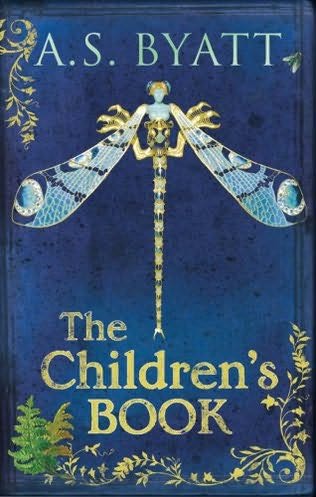
One hundred pages into A. S. Byatt’s stunning novel The Children’s Book, I've decided she wins the Booker Prize. I don't have to read the rest of the contenders. The longlist was announced today, and Byatt's on it, so she has a good shot, though my other nominee, Geoff Dyer, didn't make it. I'm putting ALL my money on Byatt. It’s a good list this year - a relief after last year’s White Tiger debacle, when so many first-rate novels were winnowed from the list in favor of unpromising first novels. What happened to Hensher's brilliant novel, The Northern Clemency, and Ghosh's Sea of Poppies? My husband hated White Tiger, and I abandoned it after 30 pages.
It’s a great feeling to discover another classic by Byatt, sink into it, fall in love with it, or whatever one does. The reviews of The Children’s Book didn’t at first appeal to me, but it's brilliant and rich with layers of allusions to children's literature: Olive Wellwood, a famous Victorian children’s book author reminiscent of E. Nesbit, writes a book for each of her children, and lives a life mainly absorbed in social life, fairy tales, and Fabian politics. It’s one of the best novels i’ve read this year and I should have ordered it right away: plot lines don’t always tell the story. The writing is extraordinary, and blended with this magnificent history of art, crafts, Victorian fairy tales, socialists, and - well, that’s as far as I’ve gotten - the beautifully-written novel has won me.
There are many fairy-tale and children’s book motifs in this novel. There is Philip, a runaway from a job at the Potteries who wants "to make things" (his sketches are elegant). This young artist hides in the South Kensington Museum, and, once discovered, is taken home by Olive , the children’s writer, to live for a short time until training and work for him are found. (This museum sanctuary seems to be a clever allusion to E. L. Konigsburg’s 1967 Newbery-winning From the Mixed-Up Files of Mrs. Basil E. Frankweiler, in which a girl and her younger brother run away to the New York Metropolitan Museum of Art. Perhaps Byatt read it to her children)
Byatt also weaves tales into the text. Olive’s disturbing The Shrubbery, which she believes almost crosses a line into terror, is included at the end of a long section about her childhood in a mining town. Olive marries up and leaves those memories behind. I read a biography of E. Nesbit this year and this certainly isn't her story, but there are other parallels: Olive’s idealistic husband quits his job, as did Nesbit's husband, Hugh Bland, and Olive talks about supporting him, as Nesbit did support Hubert.)
I ordered this from the UK because I loved Possession and her other novels (the Fredericka Quartet is my favorite) and wanted to read another contemporary classic.
I HAVE found one small Latin error, which I'm blaming on her copy editor. I have put the error in italics: "Gratias tibi agimus, omnipotens Deus, pro his et omnis donis tuis." The ablative plural of omnis is omnibus. Yes, it's a 3rd-declension adjective. Let's correct the ending to "ibus" for the paperback edition!
Here is the longlist for the 2009 Booker Prize. Some of them haven’t been published in the U.S., but I've listed their U.S. publishing date, when applicable.
Byatt, A. S. The Children's Book Oct.
Coetzee, J. M. Summertime Oct. 27
Foulds, Adam. The Quickening Maze no U.S. date mentioned
Hall, Sarah. How to Paint a Dead Man Sept. 8
Harvey, Samantha. The Wilderness already published
Lever, James. Me Cheeta already published
Mantel, Hilary. Wolf Hall Oct. 13
Mawer, Simon. The Glass Room no U.S. date mentioned
O'Loughlin, Ed. Not Untrue & Not Unkind April 1, 2010
Scudamore, James. Heliopolis no U.S. publication date
Toibin, Colm. Brooklyn already published
Trevor, William. Love and Summer Sept. 17
Waters, Sarah. The Little Stranger already published
2 comments:
I'm reading this as well (not as far into it yet as you) and am enjoying it. It's quite a rich read with lots of components and I'm not sure a first read will catch everything (which is sort of the beauty with Byatt). I've also read Sarah Waters book and Colm Toibin's, both of which I thought were excellent, so I'd be happy if any of these won. They do have a strong list this year, though I'm not familiar with all the names on the list. I'd like to give the Trevor book a try as well.
The Byatt is magnificent! (I'm about 300 pages into it now.) I have reserved some of the others from the library: it does not carry Me, Cheetah, by the way.
Last year I read one on the longlist and two on the shortlist. My husband read another three. We did NOT predict White Tiger.
You're right about Byatt: having skimmed a chapter about the '90s in a biography of Nesbit, I realize there are many, many Victorian writers to whom Byatt is probably referring - writers unknown to me. She steeped herself in the history and the period.
Very few writers are in her class.
That said, I admire Waters, Toibin, Trevor, and some others on the list, and look forward to reading their books.
Post a Comment